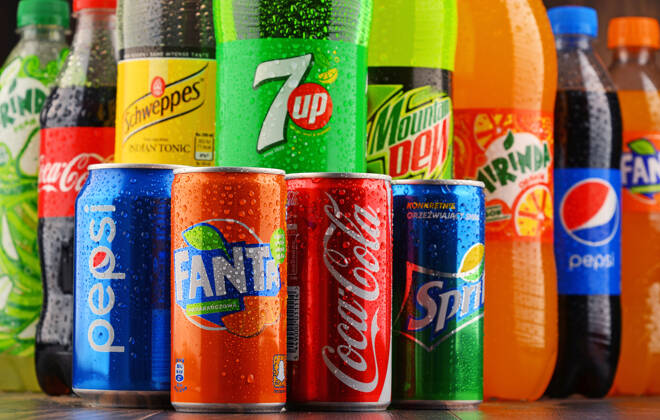Advertisement
Advertisement
PepsiCo Revenue Falls About 3% as COVID-19 Restrictions Bite; Target Price $150
By:
PepsiCo Inc reported that its revenue for the second quarter fell nearly 3% as COVID-19 pandemic drastically affected consumer spending due to strict restrictions imposed to contain the spread of the deadly virus.
PepsiCo Inc, an American multinational food, snack and beverage corporation headquartered in New York, reported that its revenue for the second quarter fell nearly 3% as COVID-19 pandemic drastically affected consumer spending due to strict restrictions imposed to contain the spread of the deadly virus.
However, the global food and beverage leader reported a strong growth in products like Cheetos, Tostitos, Doritos and oatmeal as people stocked up snacks in their homes due to the lockdown.
The company’s net revenue declined nearly 3% to $15.95 billion and net income slumped around 20% to $1.65 billion. On the other hand, online sales of potato chips climbed 93.5% and that for tortilla chips 101.2% for the week ended June 20, according to market data from Nielsen, reported by Reuters.
While PepsiCo’s snacks sales under the Frito-Lay North America unit increased 7%, sales of Quaker Oats jumped more than 20%. However, revenue at its North American beverage division, the company’s biggest contributor, declined 7% as restaurants and bars remain closed during the nationwide lockdown.
At the time of writing, PepsiCo shares traded 2.3% higher at $137.57 and it was little changed this year through Friday.
Executive comment
“Despite being faced with significant challenges and complexities as a result of the COVID-19 pandemic, our businesses performed relatively well during the quarter, with a notable level of resiliency in our global snacks and foods business. The environment has remained volatile and much uncertainty remains about the duration and long-term implications of the pandemic,” Chief Executive Officer Ramon Laguarta said in a press release.
“As a result, we are not providing a financial outlook for the fiscal year 2020 at this time. However, we continue to believe we have ample liquidity and flexibility to meet the needs of our business and return cash to shareholders.”
PepsiCo stock forecast and price target
Twelve analysts forecast the average price in 12 months at $142.64 with a high forecast of $156.00 and a low forecast of $125.00. The average price target represents a 4.15% increase from the last price of $136.96. From those 12, six analysts rated ‘Buy’, six rated ‘Hold’ and none rated ‘Sell’, according to Tipranks.
Morgan Stanley target price is $150 with a high of $175 under a bull scenario and $109 under the worst-case scenario. Jefferies raised price target to $135 from $130 and rated ‘Hold’; Deutsche Bank raised the target price to $139 from $138. We expect it is good to buy as 50-day Moving Average and 100-200-day MACD Oscillator signals a buying opportunity.
Analyst view
“We expect a positive stock reaction to a Q2 beat and Pepsi’s guidance for +LSD% organic sales growth in Q3 on the pre-recorded management call. We do note PEP expects y/y margin compression to linger but improve sequentially y/y in Q3, so margin estimates will likely come down, but we suspect the market will be more focused on topline results, particularly given near-term COVID costs will dissipate longer-term. Pepsi also commented that trends and channel dynamics improved in May and June in both developed and emerging markets. See below for country detail,” Dara Mohsenian, equity analyst at Morgan Stanley noted.
“PepsiCo is our top beverage pick. We forecast Pepsi will post superior topline growth relative to peers driven by exposure to the higher growth/higher margin snacks category (2/3 of PEP’s profit). Snacks is a higher growth category given: (1) shift to snacking vs. sit-down meals; (2) less pressure from health/wellness vs. beverages, and (3) PEP’s leading share in snacks vs. fragmented competition, driving share gains, and higher margins/ROIC. We forecast 30 bps of margin expansion with strong pricing power, and cost-cutting. Pepsi’s slight 2021 EV/EBITDA discount to US food peers (GIS/K) makes little sense given higher LT Pepsi topline growth, EPS quality, and PEP’s superior balance sheet,” He added.
Upside and Downside risks
Re-acceleration of PepsiCo’s FLNA snacks topline growth, improving North America beverages business on higher investment spend, better GM expansion on favourable commodities/better pricing realization, and higher cost savings from restructuring, Morgan Stanley highlighted as the upside risks to PepsiCo.
Lower return from PEP’s reinvestments, macro volatility, commodity and FX volatility, greater COVID impacts, greater competition in beverages, soda taxes, Morgan Stanley highlighted as the downside risks to PepsiCo.
About the Author
Vivek Kumarauthor
Vivek completed his education from the University of Mumbai in Economics and possesses stronghold in writing on stocks, commodities, foreign exchange, and bonds.
Advertisement
